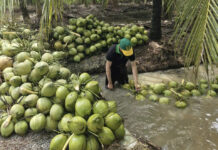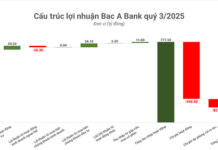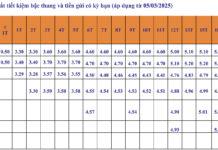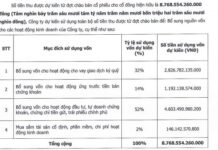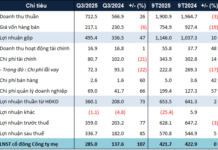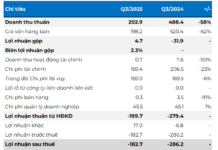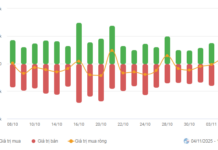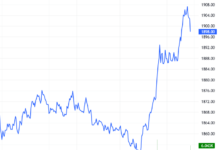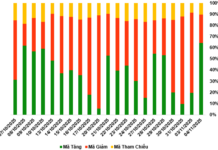According to the Vietnam Food Association (VFA), the export price of rice from Vietnam has been declining sharply in recent days. As of early March, Vietnam’s 5% broken rice was trading at $594/ton, lower than Thailand’s rice by $15/ton and India’s rice by $13/ton. Meanwhile, the 25% broken rice was trading at around $570/ton, lower than Thailand’s rice by $7/ton.
Within just half a month, the export price of rice from Vietnam has decreased by around $43/ton, and decreased by $69 compared to the peak of $663/ton achieved in December last year.
The decrease in export prices has impacted the domestic rice prices. According to reports, the prices of rice in the Mekong Delta provinces have decreased by 1,000 to 2,000 VND/kg compared to before the Lunar New Year. The downward trend is expected to continue, as farmers are concerned that the decrease in export prices will further reduce the prices of rice.

The Mekong Delta region is entering the main harvesting season, leading to abundant rice supply.
Talking to Tien Phong, Mr. Nguyen Van Don – Director of Viet Hung Co., Ltd. in Tien Giang – said that the continuous decrease in the export price of rice from Vietnam is due to the main harvesting season, which has resulted in abundant supply. Meanwhile, buyers are aware of the production situation in Vietnam, so they are proactively delaying their purchases.
“They are waiting for the rice price to decrease because companies that want to sell quickly have to reduce the price. On the other hand, businesses are also cautious because their financial resources are limited, and they need to see how the market develops before making purchasing decisions, so everything is slow,” Mr. Don said.
Mr. Don predicts that the price of rice will not decrease significantly this year and will continue to remain at a good level due to the high global market demand. Major trading partners such as the Philippines and Indonesia have announced an increase in rice imports this year.
According to Mr. Phan Van Co – Marketing Director of Vrice Group, the rice market is experiencing significant fluctuations. While the Philippines still holds the number one position as Vietnam’s rice export market, other positions, especially the French market, are continuously changing.
During the same period last year, Vietnam did not record any rice exports to this market. However, in January, the country unexpectedly became the fourth largest importer of rice from Vietnam, importing nearly 18,000 tons of rice, equivalent to a value of $18.6 million, an increase of 164 times in volume and 184 times in value compared to the previous month. Moreover, the rice price exported to this market is also very high, reaching $1,000 – $1,100.
“Businesses are also waiting to see how the importing countries are doing, how the rice trade is structured to maximize their benefits, so they are currently making limited purchases,” he added.
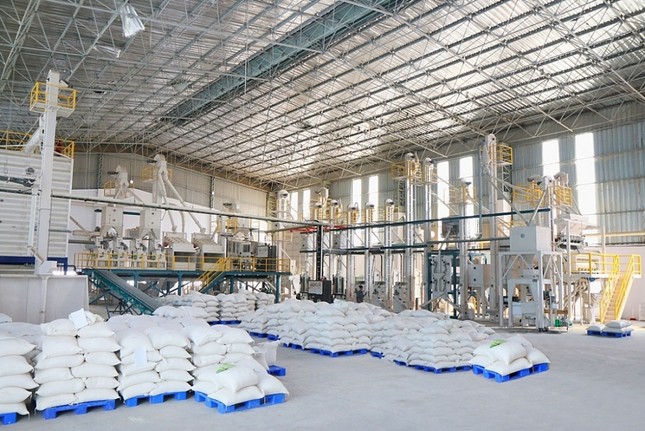
According to businesses, the slow trading activity is due to everyone waiting for the situation during the main harvesting season.
The Vietnam Food Association believes that not only rice from Vietnam, but also the prices of rice from other countries such as Thailand and Pakistan have also decreased. The decrease in rice prices is mainly due to the fact that all countries are in the main harvesting season, resulting in abundant supply, which leads to importers’ efforts to delay their orders.
According to Mr. Nguyen Nhu Cuong – Director of the Plant Cultivation Department, Ministry of Agriculture and Rural Development, the country has harvested about 3.2 million tons of rice so far. In 2024, Vietnam plans to cultivate about 7.1 million hectares and is expected to produce more than 43 million tons of rice.
Based on domestic consumption and export demand for this year, if the demand increases significantly, the Ministry of Agriculture and Rural Development will adjust the winter crop area to around 700,000 hectares, similar to 2023. However, the adjustments for the spring crop and the summer-autumn crop will be insignificant.
According to Mr. Cuong, the rice market has a narrow margin, and it fluctuates rapidly. Therefore, businesses need to actively grasp market information, forecast market trends to determine prices and export contracts with the best terms to benefit both the enterprises and the rice farmers.
“Learning from last year’s experience, businesses need to actively coordinate with relevant authorities such as the Ministry of Industry and Trade and the Ministry of Agriculture and Rural Development to closely monitor market information, seize export opportunities when there is demand from importing countries,” Mr. Cuong shared.





